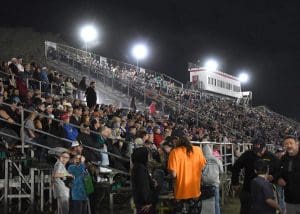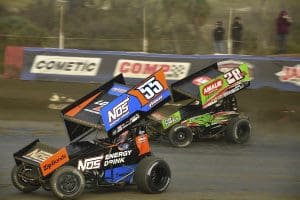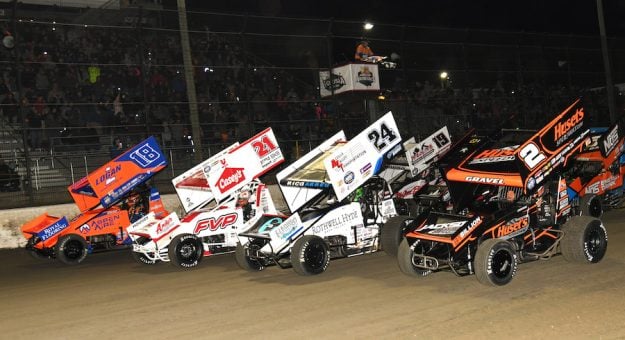While winged sprint car racing continues to thrive, there are underlying concerns about the overall future of that segment of the sport.
With the World of Outlaws NOS Energy Drink Sprint Car Series facing a new challenger in High Limit Racing — a group led by NASCAR champion Kyle Larson and five-time World of Outlaws champion Brad Sweet — some contend that two national series with more marquee events than ever will spread the sport too thin.
“I’ve heard that a lot, that there’s going to be a divide and any time you divide it’s going to be bad for the sport,” said Spencer Bayston, who left full-time World of Outlaws competition to join High Limit Racing. “I don’t entirely agree with that. There are enough professional race car drivers, a good amount of owners right now. I think it’s going to create a marketable division when High Limit drivers and Outlaws drivers will join at events. There will be a feud that fans can join in.”
Feud is a proper word given the dynamic between the two series with World Racing Group CEO Brian Carter publicly stating his frustration with High Limit Racing and Sweet firing right back with criticism about communication and decision making within World Racing Group, which owns the World of Outlaws. It was ramped up a level in the offseason as High Limit Racing hired a handful of former World Racing Group employees.
The grassroots gossip for much of the last year has been about this brewing rivalry and a concern voiced has been whether the tracks and fans can support the breadth of winged sprint car races between two national series as well as regional and local action.
“I think there’s an opportunity for that if we’re not careful,” Carter said. “There’s a finite amount of resources. Can you make it work effectively without costing somewhere? What’s the cost of it all? And it can’t be at the cost of the sport. Right now, I don’t know how it’s going to work out. There’s a finite number of paychecks and finite number of fans. I hope the number of events doesn’t exceed the amount we bring in and somebody has to pay that price. I’m worried about some of the tracks that haven’t promoted a $100,000 race and making sure they do that in a way that isn’t catastrophic.”
Sweet is optimistic that High Limit Racing is piecing together a good foundation that will yield dividends for years to come.

“There’s always negativity in anything you try to do big,” he said. “At the end of the day, Kyle and I are going to stay true to the goal of trying to help sprint car racing. What people aren’t realizing is the growth of the streaming audience and people are fully engaged, not just at the track but from afar. These resources weren’t around six or eight years ago. I think in the next three to five years a lot of this will sort itself out. We’re going to pay attention because the ultimate goal is to help. We don’t think competition is bad.
“The goal is for the race teams and team owners and drivers to see a big growth in their earnings for the amount it’s costing to put these cars on these tours. The fans are hungry for content, to see more big races. Hopefully, the fans see a huge gain and will bring friends to the races. The two that should gain the most are the race teams and race drivers, and the fan base.”
California native Dominic Scelzi will race with both series this year, spending his first two months of the season in the Midwest to prepare for a busy summer featuring marquee events along the West Coast.
“I agree with the fact it’s going to divide, but I don’t necessarily think that’s a bad thing,” he said. “With more money being thrown out you’re seeing more guys running a national series. It’s a huge incentive for teams on the cusp of being a national team. I don’t think it will be any easier to win an Outlaws race or a High Limit race, but it’ll be an opportunity for guys to win the biggest races of their career.
“For them to both be sustainable, I don’t think you’ll run more than 70 races. I think the days of running a 90-race schedule are starting to dwindle. I think we’ll see both series hone in on a 50-race schedule with bigger events.”
Who benefits the most with the newfound division in 410 winged sprint car racing?
“I’d say there are three groups,” Scelzi said. “No. 1 is racers not committed to anything, having the ability to pick and choose a schedule where you’ll be the most competitive and can chase money. You can do that for more money and you’re cutting a handful of the top guys out (who would be racing with the other series).

“No. 2 is the drivers committed to a series. Now you’ve taken some of the guys you competed night in and night out with out of the lineup. It will increase your earnings. Instead of having to race 15 or 18 guys, you’re racing a few less.
“And No. 3 is the fans. You’re seeing more big-paying events in sprint car racing than ever before. That’s amazing for the fans.”
Riverside Int’l Speedway in West Memphis, Ark., is one of only a handful of tracks that will showcase both the World of Outlaws and High Limit Racing.
“My opinion is they’ve got to work together,” Riverside owner Clayton Allen said. “The country is big enough for them to make laps around the country and stay away from each other because they both offer their own show. They have their own product. No doubt it’s all 410 stuff, but they have different products and their products will be represented differently. Hopefully they can put their egos in their pockets and look out for the fans and look out for the racers, too.”
Carter noted the effort World Racing Group is putting into making sure each race is an event is part of a bigger picture to promote the series, drivers, tracks and sponsors.
“We continue to build our promotions team,” he said. “Fan engagement, the promotion; the spend against advertising is greater than it’s ever been to help all of our partners.”
Attention to winged sprint car racing has never been greater and excitement is at an all-time high. There’s more high-paying events and even a greater number of “regular” shows that pay at least $10,000 to win.
“I’m hoping it’s spread in a really balanced way,” Carter said. “There’s a lot of tracks that have not had sprint car races that will have some high-profile sprint car races. Clearly, there’s more prize money on the line for the teams and the drivers. I think there’s going to be opportunities to reach for some people that will be opportunities they haven’t had before.
“Who benefits the most? I hope we’re all in it together.”
